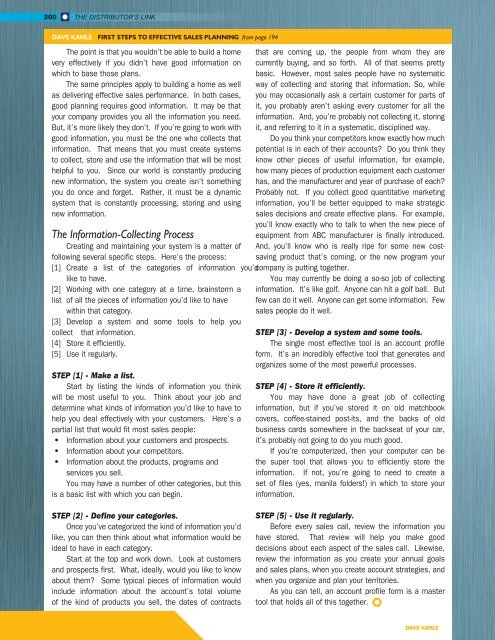SPRING 2017
Distributor's Link Magazine Spring Issue 2017 / Vol 40 No2
Distributor's Link Magazine Spring Issue 2017 / Vol 40 No2
You also want an ePaper? Increase the reach of your titles
YUMPU automatically turns print PDFs into web optimized ePapers that Google loves.
200<br />
THE DISTRIBUTOR’S LINK<br />
DAVE KAHLE FIRST STEPS TO EFFECTIVE SALES PLANNING from page 194<br />
The point is that you wouldn’t be able to build a home<br />
very effectively if you didn’t have good information on<br />
which to base those plans.<br />
The same principles apply to building a home as well<br />
as delivering effective sales performance. In both cases,<br />
good planning requires good information. It may be that<br />
your company provides you all the information you need.<br />
But, it’s more likely they don’t. If you’re going to work with<br />
good information, you must be the one who collects that<br />
information. That means that you must create systems<br />
to collect, store and use the information that will be most<br />
helpful to you. Since our world is constantly producing<br />
new information, the system you create isn’t something<br />
you do once and forget. Rather, it must be a dynamic<br />
system that is constantly processing, storing and using<br />
new information.<br />
The Information-Collecting Process<br />
Creating and maintaining your system is a matter of<br />
following several specific steps. Here’s the process:<br />
that are coming up, the people from whom they are<br />
currently buying, and so forth. All of that seems pretty<br />
basic. However, most sales people have no systematic<br />
way of collecting and storing that information. So, while<br />
you may occasionally ask a certain customer for parts of<br />
it, you probably aren’t asking every customer for all the<br />
information. And, you’re probably not collecting it, storing<br />
it, and referring to it in a systematic, disciplined way.<br />
Do you think your competitors know exactly how much<br />
potential is in each of their accounts? Do you think they<br />
know other pieces of useful information, for example,<br />
how many pieces of production equipment each customer<br />
has, and the manufacturer and year of purchase of each?<br />
Probably not. If you collect good quantitative marketing<br />
information, you’ll be better equipped to make strategic<br />
sales decisions and create effective plans. For example,<br />
you’ll know exactly who to talk to when the new piece of<br />
equipment from ABC manufacturer is finally introduced.<br />
And, you’ll know who is really ripe for some new costsaving<br />
product that’s coming, or the new program your<br />
[1] Create a list of the categories of information you’d company is putting together.<br />
like to have.<br />
You may currently be doing a so-so job of collecting<br />
[2] Working with one category at a time, brainstorm a information. It’s like golf. Anyone can hit a golf ball. But<br />
list of all the pieces of information you’d like to have few can do it well. Anyone can get some information. Few<br />
within that category.<br />
sales people do it well.<br />
[3] Develop a system and some tools to help you<br />
collect that information.<br />
[4] Store it efficiently.<br />
[5] Use it regularly.<br />
STEP [1] - Make a list.<br />
Start by listing the kinds of information you think<br />
will be most useful to you. Think about your job and<br />
determine what kinds of information you’d like to have to<br />
help you deal effectively with your customers. Here’s a<br />
partial list that would fit most sales people:<br />
Information about your customers and prospects.<br />
Information about your competitors.<br />
• Information about the products, programs and<br />
services you sell.<br />
You may have a number of other categories, but this<br />
is a basic list with which you can begin.<br />
STEP [3] - Develop a system and some tools.<br />
The single most effective tool is an account profile<br />
form. It’s an incredibly effective tool that generates and<br />
organizes some of the most powerful processes.<br />
STEP [4] - Store it efficiently.<br />
You may have done a great job of collecting<br />
information, but if you’ve stored it on old matchbook<br />
covers, coffee-stained post-its, and the backs of old<br />
business cards somewhere in the backseat of your car,<br />
it’s probably not going to do you much good.<br />
If you’re computerized, then your computer can be<br />
the super tool that allows you to efficiently store the<br />
information. If not, you’re going to need to create a<br />
set of files (yes, manila folders!) in which to store your<br />
information.<br />
STEP [2] - Define your categories.<br />
Once you’ve categorized the kind of information you’d<br />
like, you can then think about what information would be<br />
ideal to have in each category.<br />
Start at the top and work down. Look at customers<br />
and prospects first. What, ideally, would you like to know<br />
about them? Some typical pieces of information would<br />
include information about the account’s total volume<br />
of the kind of products you sell, the dates of contracts<br />
STEP [5] - Use it regularly.<br />
Before every sales call, review the information you<br />
have stored. That review will help you make good<br />
decisions about each aspect of the sales call. Likewise,<br />
review the information as you create your annual goals<br />
and sales plans, when you create account strategies, and<br />
when you organize and plan your territories.<br />
As you can tell, an account profile form is a master<br />
tool that holds all of this together.<br />
DAVE KAHLE

















